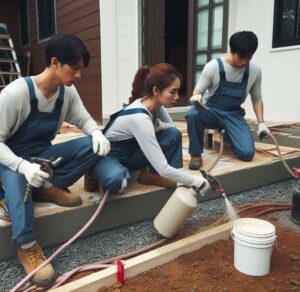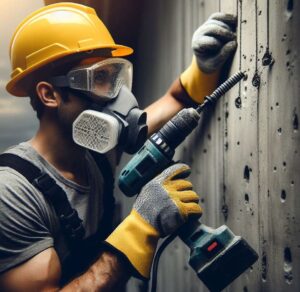Waterproofing is a crucial aspect in managing both commercial and residential properties. It involves the application of specialized substances or procedures that prevent water ingress into a property, thus ensuring its longevity and structural durability. The spectrum of waterproofing materials ranges from concrete sealers and elastomeric membranes to specialty waterproofing products. With the importance of waterproofing in mind, the focus now shifts to understanding the difference between residential and commercial waterproofing as they come with unique protocols and requirements.
Commercial Waterproofing

Commercial waterproofing is a vital aspect of maintaining structures like office buildings, factories, public facilities, and other large-scale ventures. These commercial structures typically accommodate a hive of activities, numerous people and are usually characterized by a significant volume of water usage across multiple floors. Given these factors, commercial properties require a more intensive approach to waterproofing. Any water leakage or seepage, if left untreated, can escalate into substantial structural damage and financial losses.
The process of commercial waterproofing leverages high-end techniques and state-of-the-art technology. It goes beyond the mere application of waterproofing materials to surfaces; it entails a thorough understanding of the building’s architecture, resulting in tailored waterproofing that underscores robustness and durability. These waterproofing elements are formulated to resist diverse weather conditions, constant water exposure, and regular wear and tear.
Commercial waterproofing projects can be challenging because of the industrial-grade applications. These applications, more often than not, present complex scenarios due to the types of materials used in construction, strict regulations, and high standards essential for the safety of the structure and the people using its facilities. The need for such complexity extends to the vast size of commercial properties and the detailed nuances each commercial grade property entails. For this reason, commercial waterproofing applications are quintessential in maintaining the building’s integrity.
Potential issues arising from inadequate or ignored waterproofing in commercial properties are numerous. Mold growth stands as a critical concern, potentially compromising indoor air quality and consequently, public health. Degradation of structural components is another significant worry, posing a threat to the building’s stability. Extensive property damage, in general, is an outcome most property owners would prefer to sidestep. A minor water leak can become a massive problem in a short period, if inadequately treated, causing widespread damage. Adequate waterproofing is more of an investment than an expense because it potentially saves loss of revenue due to downtime for repairs and additional expenses to rectify damage.
Investing in high-quality, effective commercial waterproofing not only ensures the building’s longevity but also contributes positively to business operations, creates a safer environment, and makes for easier property management in the long run. Without a doubt, any responsible property owner or manager should embrace waterproofing as a preventative measure rather than a mitigative one.
Residential Waterproofing
While commercial waterproofing is largely complex and extensive, residential waterproofing presents its unique set of challenges along with a different, albeit equally vital, role to play. Residential properties usually have a smaller scale than commercial buildings, but this does not detract from the importance of implementing waterproofing measures in homes. Waterproofing a residence is a critical aspect of maintaining the home’s condition, ensuring comfort, and even preventing health risks.
Various areas in a home are particularly at risk of water damage and therefore necessitate special attention. Basements, for example, are one such area of focus. These spaces, located below the ground level, are generally prone to flooding and dampness. Bathrooms and kitchens are the other common indoor areas that deal with substantial water usage, making them susceptible to leaks, humidity, and resultant water damage. Additionally, the external walls of homes, when left unattended without proper waterproofing, can absorb and retain moisture, leading to the potential deterioration of paint, insulation, and structural integrity over time.
Residential waterproofing involves the utilization of enduring materials designed specifically to withstand elements typical of domestic use. While these materials may seem less robust than those used in commercial waterproofing, they are nonetheless effective and focused on longevity. They aim to provide a strong barrier against water and dampness seeping through walls, floors, and ceilings, preventing damage both to the external structure of the house as well as the interior elements such as furnishings, appliances, and personal belongings.
The ultimate goal of residential waterproofing is far-reaching. Firstly, it serves to prevent any form of dampness or water seepage that could otherwise compromise the quality and aesthetics of the home. Preserving furniture, flooring, walls, and other components of the home’s interior is another significant benefit of residential waterproofing. Water damage can ruin expensive furnishings and even lead to structural damage if left untreated.
Preventive residential waterproofing is critical due to health risks associated with mold and mildew. These can generate persistent damp conditions, causing respiratory issues and other health problems among occupants. Waterproofing not only prevents this potentially hazardous mold growth but also contributes to maintaining a clean, comfortable, and healthy living environment.
Residential waterproofing, while straightforward compared to commercial, should not be overlooked because of its fundamental role in preserving the house’s comfort and integrity. It’s a testimony to the saying “prevention is better than cure”, as, with regular maintenance and surveillance, homeowners can prevent costly and health-threatening consequences in the long run.
Differences Between Commercial and Residential Waterproofing

Understanding the differences between commercial and residential waterproofing offers property owners crucial insights for suitable waterproofing choices.
Scale: commercial establishments, with their large spaces and industrial applications, have more extensive waterproofing requirements than single or two-story homes. For instance, a commercial property may require waterproofing for areas like underground parking lots, multiple bathrooms, or expansive external walls.
Materials: waterproofing in commercial spaces often leverages robust and resilient materials that can withstand substantial wear and tear, reflecting their large-scale usage. Residential waterproofing materials, while durable, are often less intensive.
Process: the process of waterproofing a commercial building is more intricate and detailed than a residential home due to the complexity and size of the operation.
Specialists: specialists who provide commercial waterproofing often need to undergo more advanced and specific training than those servicing residential properties. This is due to the larger scale and unique needs of commercial establishments.
Cost: given the scale, complexity, materials used, and level of expertise required, the cost of commercial waterproofing tends to be significantly higher than residential waterproofing.
While both commercial and residential waterproofing serve the fundamental purpose of shielding properties from water damage, they differ in their application scale, process, materials, and related costs. A clear comprehension of these differences can enable property owners to make the right waterproofing choices, impacting both property longevity and financial considerations. Always ensure to engage the services of a competent specialist in deciphering your property’s unique waterproofing needs.